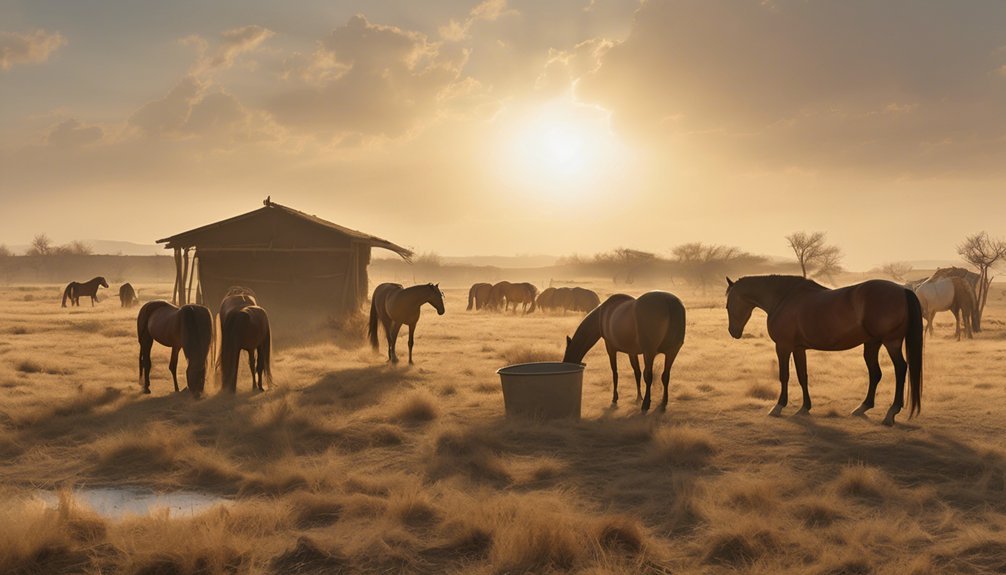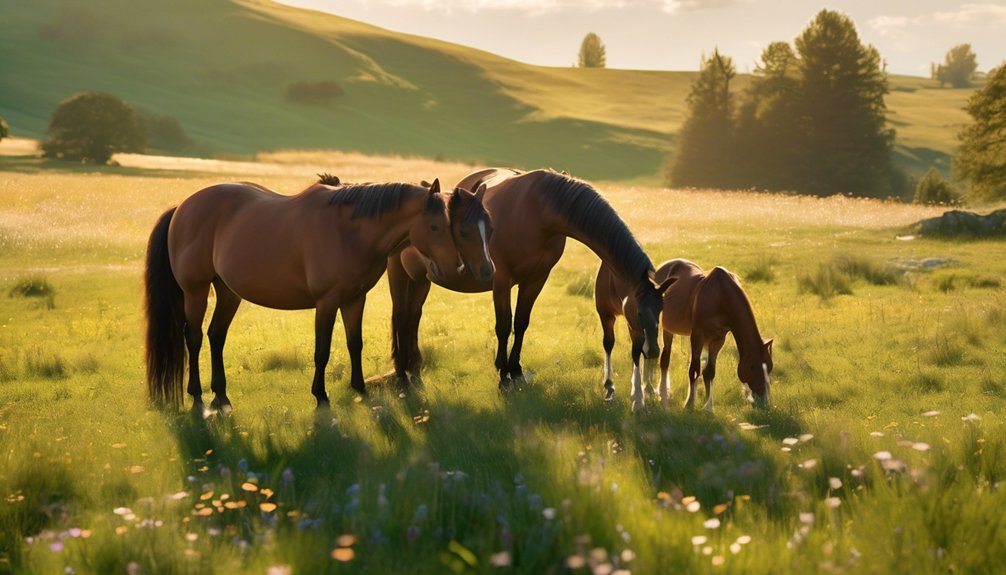
Feeding a rescue or malnourished horse isn't just about filling their trough; it's about understanding their unique nutritional needs. You need to carefully balance their diet to support recovery and overall health. Starting with high-quality hay and gradually introducing protein-rich feeds can make a significant difference. However, it's essential to monitor their response closely. Discovering the right combination of nutrients can determine their path to recovery, and there are key factors to consider.
Key Takeaways
- Provide high-quality hay and forage to support digestion and overall health during recovery.
- Incorporate high-quality protein sources, like alfalfa or soybean meal, to aid muscle repair and strength regain.
- Include a balanced mineral supplement to address deficiencies and promote bone health.
- Gradually introduce new feed to prevent digestive upset, monitoring the horse's response closely.
- Offer several smaller meals throughout the day to enhance digestion and nutrient absorption.
Understanding the Nutritional Needs of Rescue Horses

When you take on the responsibility of caring for a rescue horse, understanding its unique nutritional needs is crucial for its recovery and overall well-being.
Many rescue horses suffer from nutritional deficiencies, which can hinder their healing process. It's essential to provide a balanced diet rich in dietary fiber, as this aids digestion and promotes a healthy gut.
Ensure you're offering high-quality hay and forage, as these are vital for their physical and mental health. Avoid sudden changes in diet; instead, introduce new foods gradually to prevent digestive upset.
Monitoring your horse's body condition and adjusting their nutritional intake accordingly will help you foster a stronger bond and ensure they thrive in their new environment.
Your attentive care truly makes a difference.
Key Nutrients for Recovery
To facilitate a rescue horse's recovery, it's vital to focus on key nutrients that support healing and overall health.
Start with high-quality protein sources, such as alfalfa or soybean meal, which are essential for muscle repair and immune function. These proteins provide the amino acids necessary for your horse to regain strength.
Additionally, ensure your horse meets its vitamin requirements, particularly vitamins A, E, and B-complex, which are crucial for energy metabolism and overall vitality.
Incorporating a balanced mineral supplement can also help address deficiencies and promote bone health.
Choosing the Right Feed

Selecting the right feed for a rescue horse is a critical step in their recovery journey.
You'll want to focus on high-quality ingredients that provide essential nutrients. Start by evaluating feed types, such as high-fiber hay or specially formulated pellets designed for malnourished horses.
Look for feeds rich in protein, vitamins, and minerals, as they'll support your horse's healing process. It's crucial to avoid fillers and low-quality ingredients, as these can hinder their recovery.
Consult with a veterinarian or equine nutritionist to find the best options tailored to your horse's specific needs.
Transitioning to a Healthier Diet
As you begin transitioning your rescue horse to a healthier diet, it's essential to do so gradually to avoid digestive upset.
Start by making small dietary adjustments, introducing new feed in limited amounts alongside their current ration. This slow integration allows their digestive system to acclimate without stress.
Use effective feeding techniques, like offering several smaller meals throughout the day instead of one large feeding, to promote better digestion and nutrient absorption.
Monitor their response carefully—watch for any signs of discomfort or changes in behavior.
Remember, your horse's well-being is your priority, so take the time needed to ensure a smooth transition.
As you nurture this journey, you'll deepen your bond and help them thrive.
Monitoring Weight Gain and Health Improvements

Monitoring your rescue horse's weight gain and health improvements is crucial for their recovery and overall well-being.
You'll want to establish a consistent routine for weight tracking, ideally using a scale or body condition scoring system. Regularly assess their body condition, noting changes in muscle mass and fat distribution. This will give you insight into how well they're responding to their new diet.
Pay attention to their behavior and energy levels—these are key indicators of health. If you notice gradual weight gain and improvements in their coat, appetite, and mood, you're on the right track.
Documenting these changes will help you adjust their feeding plan as needed, ensuring they continue to thrive and regain their strength.
Supplements for Malnourished Horses
When your rescue horse is malnourished, adding the right supplements can make a significant difference in their recovery.
Start with protein supplements, as they're vital for rebuilding muscle and supporting overall health. Look for high-quality options like soy or alfalfa, which can help your horse regain strength.
Incorporating vitamin boosters is also essential, especially vitamins A, E, and B-complex, to support immune function and energy levels.
These nutrients work harmoniously to enhance absorption from their diet, ensuring your horse gets the most out of every meal.
Always consult with your veterinarian before adding supplements, tailoring your approach to your horse's specific needs.
This compassionate support can guide your horse towards a healthier, happier life.
Creating a Feeding Schedule and Routine

Establishing a consistent feeding schedule is crucial for your rescue horse's recovery and overall well-being. Aim for regular meal timing to create a sense of security and predictability.
Start with a feeding frequency of three to four small meals daily, gradually adjusting as your horse gains strength and weight. Pay attention to how your horse responds; you'll want to ensure they're comfortable and eager during feeding times.
Keeping a log of their intake can help you monitor progress and make necessary adjustments. Remember, the bond you're forming through this routine fosters trust and connection.
With patience and compassion, you'll help them thrive, turning each meal into a step toward a healthier, happier life together.
Frequently Asked Questions
Can I Feed My Rescue Horse Human Food Scraps?
You shouldn't feed your rescue horse human food scraps. Stick to established feeding guidelines to ensure their health. Human food can lead to digestive issues and nutritional imbalances, so prioritize proper equine nutrition for their recovery.
How Often Should I Feed a Malnourished Horse Daily?
You wouldn't starve a superhero, right? Feeding frequency for a malnourished horse should be multiple small meals daily, ensuring a proper nutritional balance. This way, you'll help restore their strength and vitality over time.
Is It Safe to Feed Hay Without Soaking It First?
It's generally safe to feed hay without soaking, but consider the hay types. If your horse has dental issues or is prone to choking, soaking methods can help soften the hay and make it easier to chew.
What Signs Show My Horse Is Allergic to Certain Feeds?
Seeing your horse struggle with allergy symptoms can be heartbreaking. Look for signs like itching, swelling, or digestive issues. If you notice these, consider discussing feed alternatives with a vet to ensure your horse's comfort.
Can I Use Treats During the Feeding Process?
Yes, you can use treats during feeding, but moderation's key. Opt for healthy treat types like carrots or apples, ensuring they complement your horse's diet, fostering trust and connection while promoting overall health and well-being.
Conclusion
In conclusion, feeding a rescue or malnourished horse demands careful attention and compassion. Did you know that nearly 50% of horses in shelters suffer from malnutrition? By understanding their nutritional needs and gradually transitioning to a balanced diet, you can significantly improve their health and quality of life. Your dedication to monitoring their progress and providing essential nutrients will not only support their recovery but also restore their spirit, ensuring they thrive once again.





